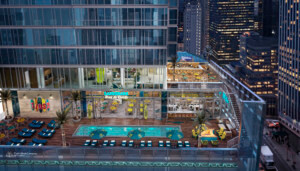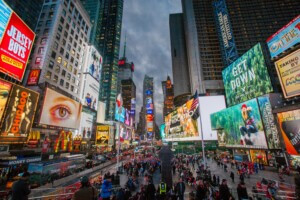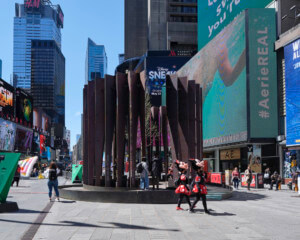It is a truth known to all architecture and design critics that there are some buildings and projects so complex, so richly textured, so incomprehensibly layered, that they require more than one visit to be fully absorbed, understood, described. It is a truth known to me—and now to you—that Margaritaville Resort Times Square, which officially started taking reservations on July 12, is one such project.
When I got this assignment, I pictured Margaritaville as having its own valence, its own gravity. But the first time I walked by, I was on my way from somewhere in Times Square to somewhere south of Times Square, heading down 7th Avenue, when my eye caught a particularly anodyne stretch of building, all gray panels, a tiny set of doors. I thought about how much New York has changed—how you can’t tell what anything is anymore, how it’s all flat frontage and nothing to see here. It wasn’t until I saw a sandwich sign advertising Volcano Nachos that I looked up, saw a much bigger sign, and realized that despite absolutely no visual street-level indication whatsoever, this was in fact Margaritaville, a 32-story tower complete with 234 guest rooms and a two-story restaurant. It wasn’t clear how to get in; it wasn’t clear if anyone ever got out.
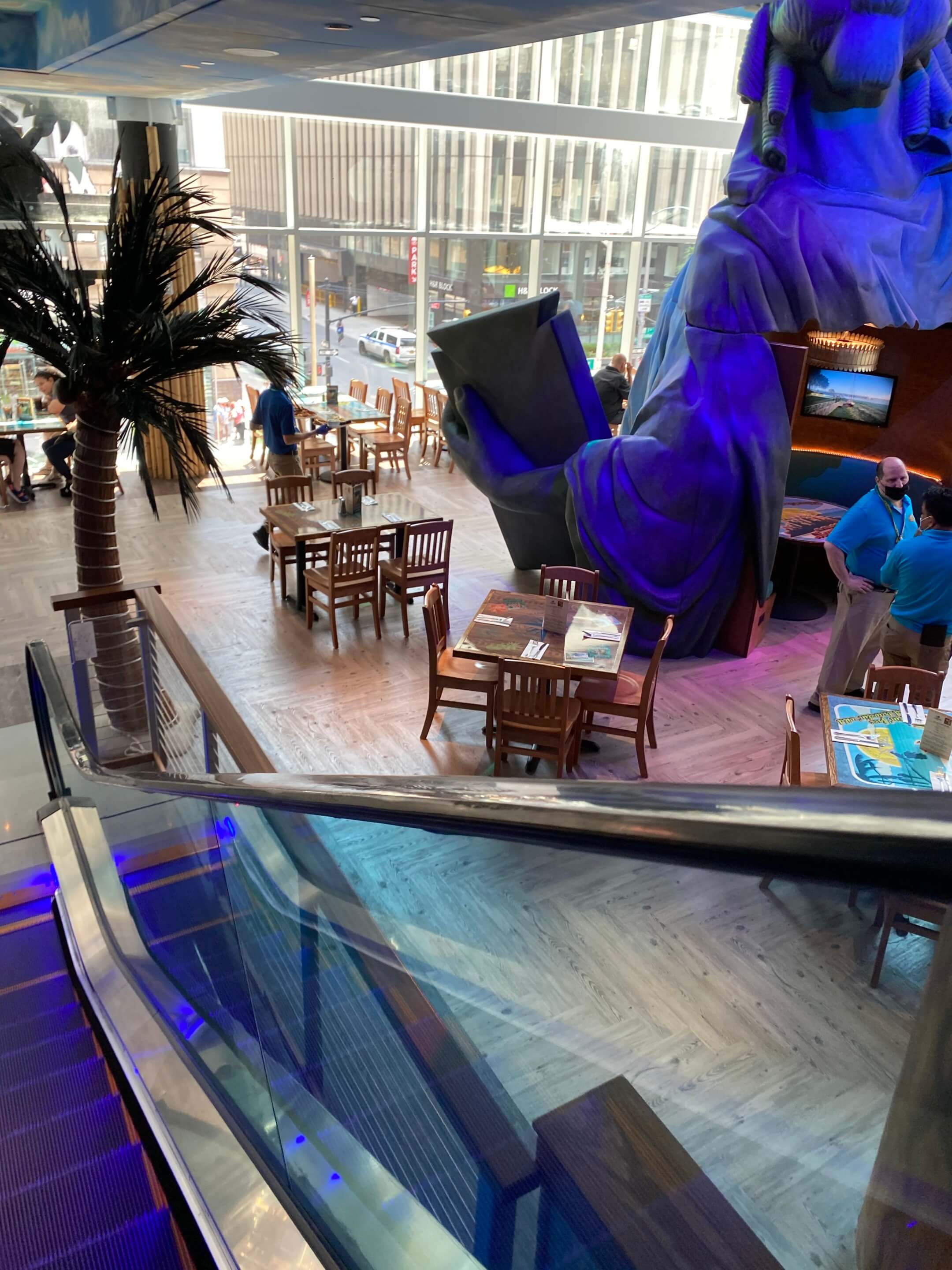
The first time I actually went in, which was my second time going by, I convinced my friend S, a design editor and writer, to meet me there. It was she who was able to talk us into the lobby by telling the very confused door person that we were definitely meeting a friend upstairs and could we just go in—yes?—even though the friend could technically come out to meet us, and also that we’d forgotten our room keys, because, really, we were staying here. It’s been about 14 years since I’ve talked my way into anywhere, and there was no way I could have gotten in without her. Security at Margaritaville is tight, apparently (though not that tight). The doorman sent us up to the seventh floor, which we accessed through a tiny ground-floor labyrinthine hallway featuring some vaguely nautical-themed decor, like a big chain (from a boat?) resting on a pale wood table against a navy (get it?) blue background. The (small) elevator opened onto a hotel lobby furnished with cabana-style seating with pictures of parrots on the wall. When I tell someone from Ohio (apparently Jimmy Buffett central) that I’m writing about Margaritaville, he says that Jimmy Buffett fans are really into parrots—so much so that, he tells me, they’re called Parrotheads. The more you know, etc. There is also a (empty) bar called Euphoria, and a coffee stand that the apologetic concierge says is the only thing open. We got our iced coffees and drank them overlooking the rooftop pool complete with beach chairs that line a stretch of terrace just above the atrium-like restaurant and overlooking 41st Street. It, too, was empty, but it looked like a lovely place to have a midtown swim.
The second time I went was by myself. I walked into the second of the two ground-level entrances and up a very long escalator. I think there was a sign that said, “Welcome to Margaritaville.” Either way, a lot of people said it. The host stand, which takes up about 89 percent of the visual space, was also vaguely nautical; there were ropes and wood and something that looked sort of like a sail. The seven people working behind the stand were all very excited that I was there for a table for one. I ordered a taco salad and started thinking about why someone would operate such a resort. Not being a business person by nature, I don’t really understand how it cost $400 million to build what feels pretty anodyne: the floor was engineered wood, the chair I sat on wasn’t particularly comfortable, and the tiki bar definitely had fake straw. A lot of the money had to have gone into the real estate, the floor-to-ceiling windows overlooking 7th Avenue and 41st Street, and maybe to the Statue of Liberty, which, my host told me, “does a show” every hour. I did not stay long enough to see the show, but I’m sure it’s tremendous.
Many years ago, I taught an undergraduate American studies lecture class on themescapes. The idea, so far as I can recall, was that themed environments do something very specific for us as a North American culture. They sort of concentrate and articulate shared fears and desires. Maybe there’s something about the simulacrum in there. Themed environments, like the Rainforest Café, or now Margaritaville, offer a concentrated vision of an idealized otherness—a way for visitors to travel somewhere without ever having to go anywhere, a way for U.S. citizens to imagine, and have imagined for us, a life that is not like ours, all while, of course, it is exactly like ours. (Vegas Paris is as Paris as Paris, maybe even more so.) As I sit here in the middle of the restaurant and finish this draft, I wonder what shared fears and desires might be articulated here, in the dummy parrot perched above the tiki bar sign, in the long sweeping teal banquette, in the six-tops, each of which displays the phrase “I just had to go back to the island.” I wonder how many people here are Jimmy Buffett fans and how many of them came for the Statue of Liberty show. I wonder what the guy with the fashy haircut is doing here. My server, Craig, is really nice and concerned by how little of the taco salad I’ve eaten.
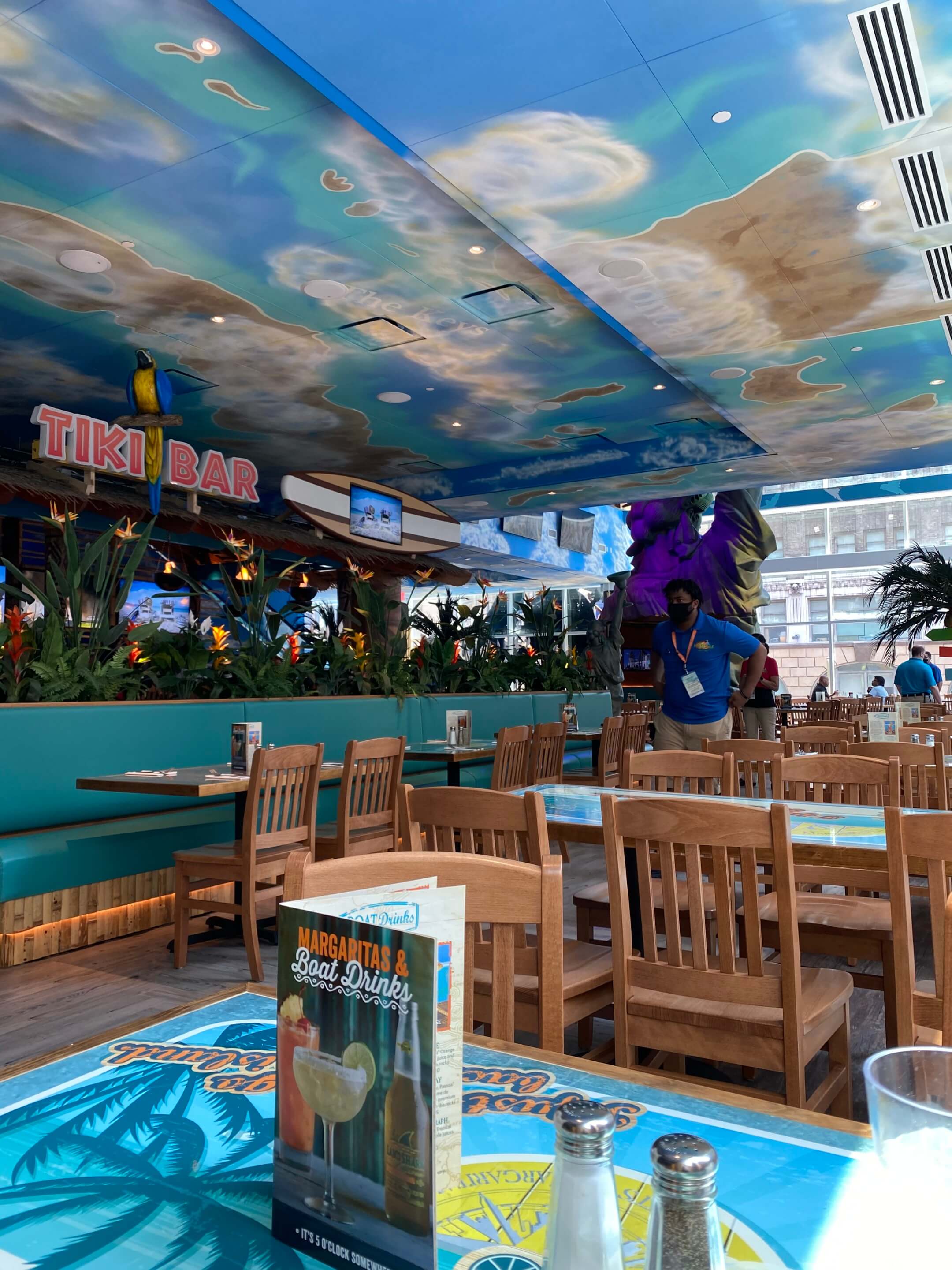
It feels like everyone else here, drinking daiquiris at the bar and, of course, margaritas at the tables at 12:30 p.m. is definitely not from New York but also could only be from New York. I guess that’s the thing about New York: its division into fiefdoms, the way in which we culturally communicate with each other. Why is it so weird that I had lunch at Margaritaville, when I like nachos and taco salads and spend a lot of time in Midtown? What if it weren’t?
I still don’t know where the $400 million went, not really, but I’m glad that a place like this exists. The restaurant is big, and not that noisy, and the ceilings are high, and the windows are huge, and it’s fun to watch the people outside walk past Yankee Doodle Dandy’s and Smoke City (“We sell the best hookahs in town”) and come out of and go into the 42nd Street subway station. I guess the thing about Margaritaville that I’ve learned after two very careful and very observant visits is that we never really know why anyone does anything, but we might as well try to enjoy it.








